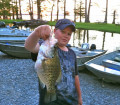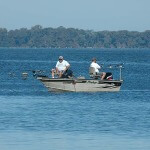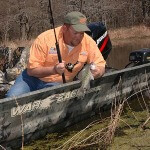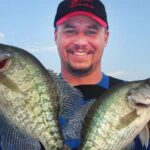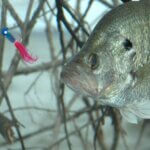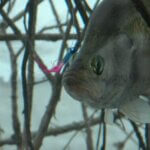John’s Note: Gilford “Sonny” Sipes of Moody, Alabama, is one of the nation’s top crappie fishermen. He and his brother, Shannon Sipes, just have won the Alabama State Championship on the Alabama River near Montgomery, Alabama, on the Crappie Masters tournament circuit. His first partner was Coy Sipes. He won the first Crappie Masters championship in 2004 in Grenada, Mississippi. His two-day catch of 20 fish weighed 37.88 pounds, the heaviest ever weighed-in for a Crappie Masters tournament. In the Alabama 2013 State Championship, Sonny and Shannon Sipes weighed-in 14 crappie, a total of 27 pounds and a few ounces. They also caught the biggest fish in the tournament, a 3.01-pound crappie.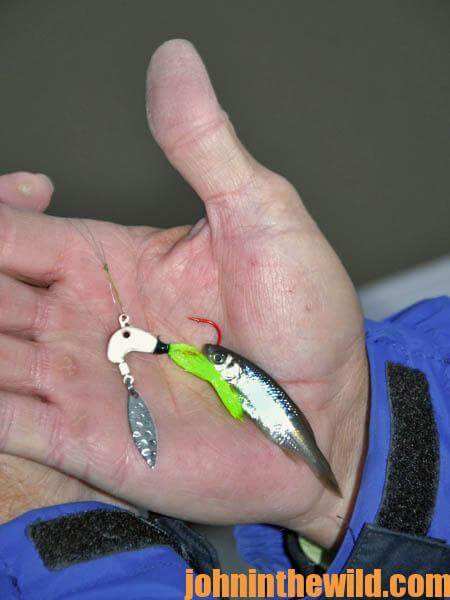
On March 22 and 23, 2013, the days of the Crappie Masters tournament, the weather had changed from temperatures in the 60s and 70s in Alabama to 20s and 30s near Montgomery, Alabama, where the tournament was held.
I asked what effect the severe weather change had on the crappie. “Believe it or not, a drastic cold front often doesn’t affect crappie at all,” Sonny Sipes says. “But that depends on how strong the urge to spawn is at the time the front hits. If crappie are determined to lay eggs, they’ll move into the shallow water and lay those eggs, even if a cold front hits. When the cold front hit the Alabama River in March, we had been catching crappie in 6 to 8 feet of water. A few years ago we were fishing a crappie tournament at Lake West Point on the Alabama/Georgia line. A severe cold front hit right when the crappie were in spawning mode. We had caught crappie in 6- to 8-foot water before the front, and the next morning when we went out to fish, those crappie still were holding in the same places. If the crappie are in 2 to 4 feet of water when a front hits, they won’t move to the 20-foot-deep river channel. They’ll just move a little deeper, possibly to 6 to 8 feet, and if I don’t find them there, I’ll move out to the 9- to 12-foot depths.
“My brother and I like to troll for crappie. We put eight poles in the front of our boat in pole holders. We use 8-pound-test Low-Vis Vicious green line as a main line, put a 1/2-ounce egg sinker up the line, tie on a crane swivel (double minnow rig) and use a 6-inch, 6-pound-test leader on the arm of the crane with a No. 1 or No. 2 Eagle Claw hook. Then we have another crane swivel tied to a No. 1 or No. 2 hook. Sometimes I’ll use a jig instead of a hook and minnow, and at other times I’ll use a hair jig with a minnow hooked to the back end. On the top of this two-minnow rig, we always use a live minnow, but on the bottom hook we use either a live minnow, a hair jig or a hair jig with a live minnow lip-hooked. During practice for a tournament, we let the crappie tell us what kinds of bait they like. Then during the tournament, we fish our double rigs with the bait selection (straight minnows, straight jigs or minnows with jigs) we’ve identified works best. We also try different colors of jigs to determine what color the crappie in a particular lake are more likely to hit. We usually go with the color that’s producing the biggest crappie on the day we’re fishing. We found before the Alabama Championship that the big crappie preferred a chartreuse-and-black hair jig on the bottom of our two-hook rig, and they also liked solid-black jigs. Our biggest crappie, the 3-pound-plus, was caught over a 13-foot bottom where the crappie was suspended at 10 feet.
 On the first day of the tournament, we trolled the backs of creeks to catch crappie that were moving to shallow water. We found about a 2-foot depression, and the crappie were holding in that depression in the back of the creek. The flat was about 5-feet deep, and the bottom of the depression was at about 7 feet, so there only was a 2-foot difference in the depth that didn’t have crappie and the depth that did. I believe the crappie were holding in that little hole in the bottom, just waiting for the water temperature to be right to move-up and spawn. We didn’t stay in the creek, because the second morning there were three-other boats fishing there. The second day, we went on the main Alabama River.”
On the first day of the tournament, we trolled the backs of creeks to catch crappie that were moving to shallow water. We found about a 2-foot depression, and the crappie were holding in that depression in the back of the creek. The flat was about 5-feet deep, and the bottom of the depression was at about 7 feet, so there only was a 2-foot difference in the depth that didn’t have crappie and the depth that did. I believe the crappie were holding in that little hole in the bottom, just waiting for the water temperature to be right to move-up and spawn. We didn’t stay in the creek, because the second morning there were three-other boats fishing there. The second day, we went on the main Alabama River.”
The Sipes team use either Tru-Turn hooks or Xpoint hooks on their minnow rigs. They also use Roadrunner lures. One of their favorites is the Roadrunner Pro 2.0 and the Lake Fork baby shad in the lime or lime trues glow colors. To learn more about the jigs and hooks that the Sipes use, visit www.roadrunnerlures.com.
Sonny Sipes also guides for crappie on several lakes in Alabama. You can contact him at 205-919-0982, or you can email him at [email protected].
To learn more about crappie fishing, go to http://www.crappiemasters.net/home. Or, to view an online crappie fishing magazine, go to http://www.crappienow.com/home.
To learn more about how to catch crappie, click here to get John E. Phillips’ latest crappie-fishing book, “Crappie: How to Catch Them Spring and Summer.”
About the Author
John Phillips, winner of the 2012 Homer Circle Fishing Award for outstanding fishing writer by the American Sportfishing Association (AMA) and the Professional Outdoor Media Association (POMA), the 2008 Crossbow Communicator of the year and the 2007 Legendary Communicator chosen for induction into the National Fresh Water Hall of Fame, is a freelance writer (over 6,000 magazine articles for about 100 magazines and several thousand newspaper columns published), magazine editor, photographer for print media as well as industry catalogues (over 25,000 photos published), lecturer, outdoor consultant, marketing consultant, book author and daily internet content provider with an overview of the outdoors. Click here for more information and a list of all the books available from John E. Phillips.

